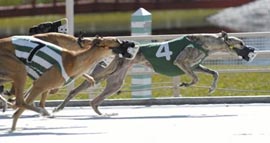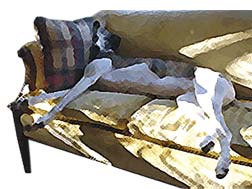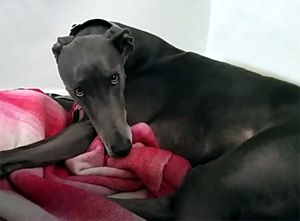Greyhounds Make Fantastic Pets
The majestic and graceful Greyhound has been revered as companion and hunter throughout history, with paintings and other depictions dating back some 4,000 years. The Greyhound is one of the most ancient breeds of dog in the world. The only breed of dog mentioned by name in the Bible is the Greyhound. In Egypt, the ancestors of modern Greyhounds were used in hunting and kept as companions. In fact the Egyptians considered the birth of these dogs to be second in importance only to the birth of a son.

The arrival in England of the Greyhound dates back approximately 3,500 years and they were introduced to America in the late 1800s as pest control for the jackrabbit. Greyhounds were popular among the royalty and nobility of England in the nineteenth century.
Greyhound racing in the modern sense of the term began around 1912 with the first circular track being opened in 1919.
Greyhounds are lithe sight hounds, bred to run and hunt. They have the build of an athlete, the grace of a dancer and are the fastest breed of dog. Incredibly the Greyhound can also add intelligence to its list of enviable qualities.
Approximately 10,000 racing Greyhounds retire each year. Once they stop making money for the owner the lucky ones become that owners pet and the rest are sadly disposed of. Some are humanely destroyed, some are re-homed and others are sold on to countries abroad to continue racing, often enduring hot climates and poor living conditions. Those being re-homed in the UK are of course helped by the rescue charities, who do their very best to re-home the large number of dogs coming into their care.
Greyhounds Make Wonderful Pets
The Greyhound can have a hard time finding a new home. It is not clear why because they make wonderful pets. Could it be that a general misconception exists with regards the Greyhound, especially the ex-racer?
 Let’s take a closer look at today’s Greyhound and restore their reputation as worthy companions.
Let’s take a closer look at today’s Greyhound and restore their reputation as worthy companions.
Myth: Greyhounds require a lot of exercise
The Greyhound may be fast and an incredible athlete but at home they are renowned couch potatoes. As a breed they are generally very laid back. They need some exercise in order to stay mentally and physically fit but one fairly short walk on lead everyday is all they require. Other than that, a secure garden at home is an adequate play area for your Greyhound. Greyhounds are not known escape artists, so 6 foot solid fencing is not required. The Greyhound may be fast and an incredible athlete but at home they are renowned couch potatoes.
The Greyhound is a sight hound with a strong instinct to chase. They can go off lead once their relationship with their owner is strong and once adequate recall has been achieved. Even then, it is recommended that Greyhounds are only let off lead in a secure area. Many owners also muzzle their dogs. Contrary to popular belief, Greyhounds are not required by UK law to be on lead or muzzled when on their walk, but it is a precaution that the owner may choose to take. The Greyhounds instinct to chase small furries and in fact anything else that moves, even a leaf blowing across the ground, is definitely something to seriously bear in mind.
Myth: Greyhounds find it hard to settle into a home life
An ex-racers ideal retirement would be in a loving home, living out the rest of their lives as a lazy family pet. Indeed, they adapt to the life of a family pet with considerable ease. Greyhounds are also quiet dogs who rarely bark and not given to excessive demonstrations.
Myth: Greyhounds need a lot of care
With their short, smooth coats and very little oil, the Greyhound has little doggie odour and requires minimal grooming or bathing. Any shedding is easily kept to a minimum with regular brushing of the coat with a soft bristle brush.
Myth: They have health problems
As a breed, Greyhounds are genetically one of the healthiest. They don’t have any inbred genetic physical problems. Greyhounds can be prone to bone fractures but this is not an inherent trait. Some eye diseases are reported but as recessive traits.
The ex-racing Greyhound may have been retired for a number of reasons. Aside from not being a good racer, the most common reason is because of injury. Damage can be caused by collisions and mishaps but also the sharp bends of the track put enormous strain on the dog's joints and toes. Most Greyhounds have joint issues, with Degenerative Joint Disease being the most common. The majority have arthritis which you may or may not notice.
Myth: They are large and will get in my way
Size varies depending on the breeding line but, to give a general example, a Greyhound’s height is approximately 25-30 inches and their weight is approximately 30-40 kilos. So yes, the Greyhound is a large dog but light, agile and graceful with it. This breed is not under your feet and does not tend to get in your way every minute of the day. They are often quite happy to just be in the same room with you, most probably snoozing.
Myth: Greyhounds are unsociable
 Greyhounds have been bred for thousands of years to be sociable, non-aggressive animals who work well with others. Greyhounds are by nature gentle creatures who can develop strong relationships with humans. In fact, the Greyhound adores human company.
Greyhounds have been bred for thousands of years to be sociable, non-aggressive animals who work well with others. Greyhounds are by nature gentle creatures who can develop strong relationships with humans. In fact, the Greyhound adores human company.
With regards other animals including other breeds of dog, it is wise to bear in mind that the Greyhound is a hunter and may not easily distinguish cats or smaller breeds of dog from the small animals they were bred to hunt and chase. However, Greyhounds will come to accept almost any animal once they learn the other pet is a member of the family. There are always exceptions, of course.
Myth: They are not easily house-trained
Racing Greyhounds are "kennel broken". They have been taught to toilet outside and keep their sleeping areas clean. This knowledge is usually readily transferred to their new lives in the family home. All you need to do is teach them where they can and can’t toilet, which is easily done as the Greyhound is an intelligent breed of dog and fairly obedient.
Myth: Greyhounds are not good with children
On the contrary, they are actually very gentle and patient animals. However, they do not want to be harassed by anyone, including children. A child to any dog can seem small and annoying. If the Greyhound does feel bothered by a situation, say with an overenthusiastic child, they are more likely to walk way than to snap. Any dog has its limits. Small children must always be supervised when in the company of any breed of dog.
Myth: The breed is difficult to walk on lead
Most Greyhounds have been trained to walk on lead. They prefer to walk on a slack lead. For dogs of their size they are unusually easy to handle. They respond very well to gentle touch and firm voice commands.
Myth: Only certain people suit a Greyhound
As a breed, Greyhounds are gentle, affectionate and remarkably calm in temperament. Greyhounds make ideal companions for the elderly. They are very quiet in the home and do not bark and rush around. The discipline of kennel life stands them in very good stead. Many Greyhounds make excellent PAT dogs or other therapy dogs, giving companionship and love to people in nursing homes or people with disabilities.
The characteristics of the Greyhound mean that they have become the pet of choice among an increasing number of people.
Probably, of all these points covered, the exercise myth is the most well known and inaccurate. It seems clear that Greyhounds are quiet, unassuming companions who require and demand very little.
Greyhounds are usually not very old when they retire and become available for adoption. They are typically 2-5 years of age when they retire and have an average life span of 12-14 years.
Adopting a Greyhound
 If you are considering adopting an ex-racing Greyhound, you will be thinking about how best to settle your new companion into your home. This is particularly crucial for an ex-racer who has probably never experienced family life.
If you are considering adopting an ex-racing Greyhound, you will be thinking about how best to settle your new companion into your home. This is particularly crucial for an ex-racer who has probably never experienced family life.
Any dog being re-homed is likely to be a little anxious and withdrawn. You must let them take things at their own pace and realise that how they seem initially is not an indication of what they will be like once they fully settle in. In time your Greyhound’s true personality will start to show as he comes out of his shell, begins to trust you and settles into his new life. In the meantime, your Greyhound will be very glad for a quiet bed to call his own. Allow him to settle in his bed and to have some space to come to terms with the upheaval and excitement of all the new experiences. Have patience.
Greyhounds are sensitive, may startle easily at first and only need to be spoken to gently and softly. Let them explore and use a gentle ‘no’ plus a blocking motion if appropriate to stop unwanted behaviour. As with all training, show an alternative behaviour instead. The greyhound will appreciate everything to be done quietly and calmly.
Remember this is a whole new world to your Greyhound so bear in mind that they will be easily confused or distracted by all the new things they see at home and on their walks. Their safety is in your hands. Training can be as rewarding with a Greyhound as with any dog. Recall training is the most important lesson for your ex-racer.
Also remember that the racing Greyhound has seen few animals, even dogs of other breeds. They may take time to understand the new creatures they encounter. A small breed of dog can seem remarkably similar to the mechanical hare!!!
The Greyhound has a constitution like many highly-bred animals. With gentle guidance they will thrive but harsh words or impatience can shatter their confidence and make them go to pieces. Take their training slowly so that they don’t have to take too much on board in one go. If you are relaxed and affectionate your greyhound will be too. Your dog has a lot to learn but the Greyhound is adaptable and often young enough to still fit in with ease.
Almost everything is going to be new and either exciting or frightening to your Greyhound at first. You will need to reassure them and be there for them. They are likely to prefer to stay nearby you at night as well. The desire of your Greyhounds remaining life is likely to be to please you and to stay near you.
We'll let this darling ex-racer Blue have the last word.
Further Information or Adoption
Approximately 10,000 racing Greyhounds retire each year. The lucky ones become pets and the rest are sadly disposed of.
Celia Cross Greyhound Trust
Retired Greyhound Trust
Forever Hounds Trust
Dogs Trust
Battersea Dogs and Cats Home
By Jenny Prevel
© D for Dog www.dfordog.co.uk
This article belongs strictly to D for Dog and we do not authorise the copying of all or any part of it.

Thank you so much that was brilliant and so much help.
Thank you just adopted a retired greyhound had him for 3 days now all true your article he is a darling no trouble at all not even chased the cat!
We have rescued 2 retired greyhounds and they are the most fabulous dogs. I can’t begin to say how much they have changed my family’s life. They are the most affectionate and loving dogs and we think every house should have 1! We also have a rescue lurcher who is also a fabulous dog! We can’t imangine life without greyhounds or lurchers!
i adopted a retired greyhound a month ago and she is the most super dog i have ever met. She is gentle, clever, funny, loving, and so wants to please me. I could go on and on. I wish I had known how lovely they were i would have adopted one years
ago. she has got used to family life so quickly and for a big dog in my small house, her size is no problem at all. everybody loves her.I think everyone should have a greyhound. I may even go and get another one....